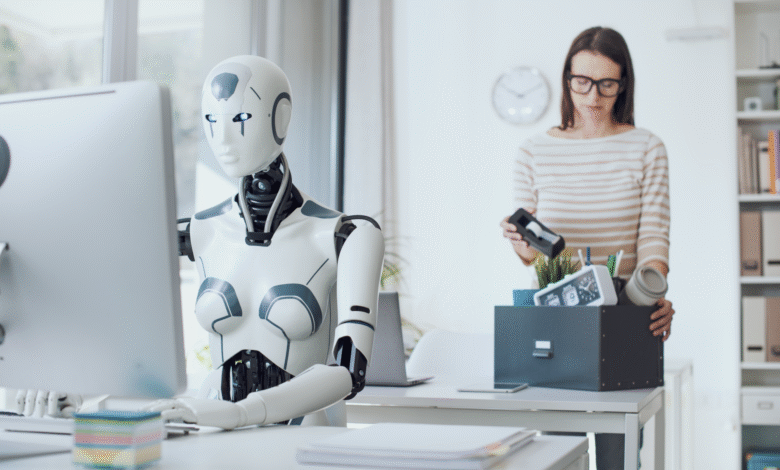AI Job Displacement: Revealing Trends in Workforce Changes

In recent years, the topic of AI job displacement has become increasingly prominent as companies begin to integrate artificial intelligence into their operational frameworks. Major players like IBM and Klarna have openly acknowledged that AI is replacing certain roles, signaling a significant shift in the employment landscape. However, many businesses continue to disguise these job cuts under euphemistic terms such as restructuring or optimization, which may obfuscate the true impact of AI on the workforce. As automation technology advances, the potential for automation job losses raises concerns about the future of work in an AI-driven economy. Understanding the ramifications of these changes is crucial for employees and job seekers navigating the evolving labor market.
The evolution of the workforce in light of artificial intelligence is a topic of urgent discussion, as the integration of intelligent systems leads to shifts in traditional employment paradigms. This transformation, often referred to as automation-driven workforce changes, suggests that numerous positions could soon become obsolete, particularly in sectors reliant on repetitive tasks. Companies embracing AI technology frequently opt for less explicit language to communicate changes, instead framing reductions as part of broader strategic initiatives. Consequently, the implications of these corporate decisions have a profound effect on future employment trends, calling attention to the necessity for workers to adapt to the emerging landscape of the job market powered by intelligent automation.
The Hidden Impact of AI on Job Displacement
Artificial intelligence (AI) is reshaping the landscape of employment in profound ways, yet many companies choose to communicate layoffs using euphemisms like ‘restructuring’ or ‘optimization.’ This masking of the true cause masks the significant role AI plays in employment shifts. For instance, firms such as IBM have publicly acknowledged replacing HR positions with AI chatbots, a shift that unveils how AI is not merely a tool for efficiency but a primary catalyst for workforce displacement. As IBM leads the charge in transparency, other companies remain tight-lipped, leaving a cloud of confusion among employees and the public regarding the future of work in an increasingly automated environment.
The reluctance to directly link layoffs to AI further obscures the potential consequences for the workforce. Experts suggest that many companies, wary of backlash, employ vague language to shield their motives. While the economic indicators may appear stable for now, the underlying truth is that as AI technologies are integrated, they initiate a wave of job losses that companies are hesitant to admit. With claims of operational enhancements, workers are left uncertain about job security in sectors profoundly affected by automation.
Companies’ AI Layoffs: The Fine Line of Transparency
As automation and AI take a central role in corporate strategies, the delicate dance between transparency and operational secrecy becomes evident. Some organizations, such as Klarna, openly discuss the transformative effects of AI on their workforce, stating a stark reduction in employee numbers as they lean on technology. However, others continue to couch job cuts in broad terms, fearing the repercussions of openly conceding that technology has supplanted human roles. This avoidance not only misleads the public but may also undermine trust amongst remaining employees, who witness peers being replaced but lack clarity on the driving factors behind these decisions.
The chilling effect of this lack of communication can foster a culture of uncertainty and resentment within companies. It stirs anxiety among employees who may feel invisible to the broader organizational strategy, prompting a potential decline in morale and productivity. In an era where job security is already compromised by the ever-evolving landscape of technology, organizations must tread carefully, as failure to address the reality of AI-related job displacement openly could lead to long-term consequences in workforce dynamics.
AI Workforce Changes: A New Era of Employment
Innovation through AI has catalyzed a significant shift in workforce dynamics, as companies seek to streamline operations and enhance efficiencies. This new era of employment, characterized by job displacement due to automation, necessitates an adaptive response from both businesses and employees. Companies are increasingly compelled to reassess their human resource strategies and the roles that remain irreplaceable in the face of advancing technology. Those positions requiring creativity, emotional intelligence, and nuanced decision-making continue to hold value even amidst rising AI efficiency.
As firms restructure their operations, the focus invariably shifts towards harnessing AI capabilities to perform repetitive tasks, thereby reallocating human talent to more strategic functions. The future of work suggests a hybrid model where collaboration between AI and humans is essential. This blended approach necessitates a renewed emphasis on upskilling workers to adapt to the changing demands of the job market, ensuring they possess the requisite skills to thrive alongside AI technologies.
Automation Job Losses: Economic Implications
The economic ramifications of automation job losses are becoming increasingly apparent as industries embrace AI technologies. With projections indicating that over 41% of employers plan to reduce their workforce within the next five years due to automation, it’s crucial for both policymakers and business leaders to consider the broader implications of these shifts. Economic growth, while robust in some sectors, could be stymied by significant job losses in traditional roles. Thus, maintaining a balance between technological advancement and workforce welfare stands as a formidable challenge.
Importantly, this scenario raises questions about the social safety net and workforce re-employment strategies. As companies lean more heavily on AI to drive productivity, it becomes essential for governments to implement training programs and transition support for affected workers. Without proactive measures to address these job losses, the economic landscape may face instability, prompting higher rates of unemployment and decreased consumer spending, ultimately jeopardizing sustainable growth.
The Role of AI in Future Employment Strategies
As we navigate the complexities brought forth by AI’s integration into the workplace, organizations are challenged to reevaluate their employment strategies to remain competitive while also being fair to their workforce. The future of employment hinges on embracing AI with a clear vision that balances efficiency gains and human talent retention. Transparency forms an essential element of this vision; organizations that embrace open communication regarding workforce transitions can foster a more inclusive culture that acknowledges the contributions of human employees.
Moreover, companies must take a holistic approach to workforce planning, ensuring that as AI implementations grow, so too does their commitment to workforce development. By investing in skill enhancement initiatives and positioning employees for roles adjacent to automation, businesses can cultivate an agile and resilient workforce. This foresight not only alleviates potential backlash from displaced workers but also enhances organizational loyalty and engagement, fueling a sustainable future in an AI-dominated landscape.
AI’s Impact on Employment: A Paradigm Shift
The impact of AI on employment represents a paradigm shift with potential far-reaching consequences for job markets worldwide. As automation continues to evolve, entire sectors face reevaluation of job roles, skill demands, and the nature of work itself. Many companies remain hesitant to admit the direct relationship between AI deployment and job cuts, often characterizing changes through broader operational language that obscures the underlying reality. This lack of transparency not only misleads stakeholders but also can create a fallout that companies will need to grapple with as the workforce adapts to new realities.
Moreover, as AI capabilities expand, the demand for new skills will surge, further emphasizing the critical necessity for ongoing workforce education. This demand brings forth an opportunity for organizations to take a proactive stance, aligning training programs with evolving industry requirements. As workers prepare to meet the needs of a high-tech landscape, the focus must shift to creating an environment where continuous learning is prioritized, empowering employees to adapt alongside AI innovations.
The Future of Work with AI: Navigating Challenges
As AI’s presence looms ever larger in the workforce, navigating the accompanying challenges becomes paramount for organizations aiming to equip themselves for the future. The potential for significant job losses creates pressing issues related to employee morale, public perception, and regulatory scrutiny. By embracing AI technology while simultaneously addressing the existential fears of labor displacement within their workforce, companies can foster a culture that is both innovative and supportive. Clear communication about the role of AI in future work processes becomes an imperative to diminish resistance among employees who might perceive change as a threat.
Consequently, leaders are tasked with shaping a vision for the future that harmonizes technological advancement with human capital development. Considerations for maintaining engagement and trust will be essential as AI technologies are integrated into various business functions. Ultimately, the way forward lies in establishing an organizational ethos that champions adaptability, aligning both workforce and technology in a collaborative partnership that drives future success.
Corporate Responsibility in an AI-Driven Economy
In the face of AI-driven changes, corporate responsibility assumes a critical role in shaping how companies approach workforce management. Organizations must recognize their obligations not only to shareholders but also to employees who may be vulnerable to job displacement due to automation. The introduction of AI should not come at the expense of human jobs; instead, it requires a commitment to ethical implementation that balances operational efficiencies with social accountability.
This responsibility extends to advocating for a workforce that is educated and equipped to transition into new roles that AI will create. In doing so, these corporations have the opportunity to lead the conversation on how to harness technological advancements without compromising the human element of work. Building a robust framework centered on employee growth and sustainable employment practices will not only mitigate backlash from stakeholders but also position companies as pioneers in ethical AI implementation.
Preparing for the Inevitable Shift Towards Automation
Preparing for the inevitable shift towards automation requires organizations to adopt a proactive stance on workforce restructuring. With predictions indicating that a significant proportion of the current workforce could be impacted by AI technologies, it is essential for businesses to initiate strategic planning that addresses these forthcoming changes. Organizations must consider how to transition roles within their workforce, offering pathways for employees to adapt and thrive in the new economy.
Additionally, fostering partnerships with educational institutions to enhance skill-building efforts will be paramount in supporting employees through this transformative phase. Emphasis on reskilling programs will help fill the gaps between current employee capabilities and the demands of future roles, ensuring a smoother transition into an AI-augmented working environment. As the pace of automation accelerates, those companies that prioritize employee empowerment will undoubtedly emerge as leaders in the new technological landscape.
Frequently Asked Questions
How is AI impacting job displacement in various sectors?
AI is significantly reshaping the workforce, leading to job displacement primarily in sectors like customer service, content creation, and operations. Many companies are automating these roles, often using euphemisms such as restructuring or optimization, which camouflages the reality of AI job displacement.
What evidence suggests AI is causing automation job losses?
Recent reports reveal that companies like IBM have replaced human employees with AI chatbots, with large-scale layoffs often occurring post-AI deployment. Additionally, the World Economic Forum predicts that 41% of employers may reduce their workforce within five years due to AI automation, illustrating the direct impact of AI on job displacement.
Are companies transparent about AI layoffs and job displacement?
Generally, companies tend to be vague about AI job displacement, opting for terms like reorganization instead of explicitly stating that AI is the reason for layoffs. Experts suggest this strategic silence helps companies avoid backlash from employees and the public regarding automation job losses.
What industries are most affected by AI job displacement?
Industries like fintech and customer service are heavily impacted by AI job displacement, as companies increasingly invest in AI technologies capable of handling operations that were previously managed by human employees. This trend highlights the growing reliance on AI across various sectors.
How can workers adapt to the changes brought by AI in the workforce?
Workers can adapt to AI job displacement by reskilling and upskilling to stay relevant in an evolving job market. Embracing continuous learning in areas where human expertise complements AI, such as creative roles or strategic decision-making, can help individuals remain competitive.
What role do layoffs play in the future of work with AI?
Layoffs are increasingly seen as a byproduct of AI adoption, as companies streamline operations through automation. This trend sets the stage for a future where AI not only enhances productivity but also redefines roles, leading to significant changes in employment landscapes.
How do companies mask AI’s role in job cuts?
Companies often use euphemisms like restructuring or optimization to describe job cuts caused by AI implementation. This approach allows them to manage public perception and avoid backlash, despite the underlying reality of AI-driven workforce reductions.
What is the long-term outlook for jobs affected by AI?
The long-term outlook for jobs affected by AI is increasingly concerning, with predictions indicating that many entry-level office jobs could be eliminated. As AI technologies continue to advance, job displacement is expected to accelerate, requiring a robust response from both workers and employers.
Why are many companies reluctant to disclose the impact of AI on employment?
Companies hesitate to disclose the impact of AI on employment for fear of negative reactions from employees, customers, and investors. This reluctance stems from concerns about potential backlash over automation job losses, which could affect employee morale and public perception.
What can we expect regarding future AI workforce changes?
As AI technologies evolve, significant changes in the workforce can be anticipated. Companies are likely to adopt more transparent communication regarding AI job displacement, but by then, the effects will be substantial, emphasizing the need for individuals to adapt to a rapidly changing work environment.
| Key Points |
|---|
| IBM and Klarna openly acknowledge AI’s role in job displacement, unlike many firms that use vague terms. |
| Many companies prefer to say layoffs are due to restructuring, concealing AI’s influence. |
| Experts believe AI-related job reductions are more common than admitted by companies. |
| Companies often refer to layoffs as efficiency moves to avoid backlash. |
| The financial health of companies suggests that layoffs are linked to AI rollouts, not traditional financial struggles. |
| Despite AI’s capabilities, companies may still require human involvement, especially in complex tasks. |
| Transparency about AI replacing jobs is often avoided due to fear of public and employee backlash. |
| The World Economic Forum predicts 41% of employers will reduce their workforce due to AI within five years. |
Summary
AI job displacement is becoming an increasingly pressing concern as major companies pivot towards automation. While corporations like IBM and Klarna are candid about AI’s role in replacing human workers, many firms still shy away from revealing the true extent of these changes, often cloaking job cuts in euphemisms like “restructuring” or “optimization.” This trend signals a deeper, unacknowledged influence of AI in the workforce, and as more sectors adapt to technological advancements, the potential for job loss grows. As we move towards an era where AI is integrated into various industries, the imperative for transparency and adaptation is crucial for both companies and employees alike.




